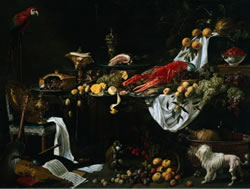|
The word ekphrasis comes from the Greek ek and phrasis—out and speak. It conjoins the twin impulses of writers to divest themselves of the story within them, to get it out, as it were, or to draw it out of something or someone, and to do so in words, with language. To speak it.
Originally the word simply meant a description of something, but in the twentieth century it has come to mean more narrowly a dramatic description of a work of art.
The created image—a painting, a sculpture, a photograph—contains within it what we know instinctively is a whole world, a thing complete unto itself. In a museum, we stand before these images: a still life painting of flowers and fruit, a white-cheeked monkey seated on its haunches beneath the table, for instance, or a depiction of a battle, smoke rising from the field.

"Banquet Still Life," 1644, by Adriaen van Utrecht
The details of these compositions, whatever they are, make a whole and finished entity, something that requires a frame. There was something here, the fact of the painting suggests, something that arrested the artist and captured his attention, causing him to stop and stare. He has seen something powerful in the arrangement of details before him, and he has drawn a deliberate frame around it.
A story, too—with its beginning and middle and end, in its artful construction and arrangement of events—makes a whole and finished world. We may sense—and perhaps this is a requirement of a successful story, in fact—that a larger universe containing the story, its people and places and things, exists outside of and before the curtain rises on the events that the story will relate, and that that universe will continue to exist after the curtain falls. The timeline of a story extends invisibly both before the first page and after the last. We understand, for instance, that Moby Dick was swimming in the cold deep waters of the Atlantic long before he took off Captain Ahab's leg, and further fates await Ishmael, after he is fished from the water and his hold upon Queequeg's coffin. This sense of a story enduring somehow past the page is a necessary aspect of its success. If the story is a good story, well made, we do not sense that its characters were invented—like Eve from Adam's rib—for the purpose or convenience of the artist and his story. They are out there somewhere in the imagined world of the fiction in which we have come to believe so powerfully, even as we know simultaneously, paradoxically, that it is all a figment, a lie, an invention in the mind of the writer which is passed to us and enters our minds through words arranged on the page.
Yet the sense of completeness in a work of art—the truth it captures, the importance at its center, the sense that something indeed resides at its center—is what Socrates meant, I think, in his remarks to Phaedrus.
We feel, gazing at these scenes, that we are looking upon the fullness of a moment in time, upon things that have texture (that monkey's dusky coat) and scent (those overripe grapes, that ribbon of lemon rind) and sound (cannon fire and cries of pain and hoof beats).
"You know, Phaedrus," he said, "that is the strange thing about writing, which makes it truly correspond to painting. The painter's products stand before us as though they were alive. But if you question them, they maintain a most majestic silence. It is the same with written words; they seem to talk to you as if they were intelligent, but if you ask them anything about what they say, from a desire to be instructed, they go on telling you just the same thing forever."
Socrates doesn't mean, I think, that a work of art—a painting or a story—fails to communicate or is actually "silent." By a painting's "majestic silence," by a story's saying the same thing over and over, its words and sentences and scenes never changing on the page, he means that a particular and mysterious and irreducible meaning has been conveyed, a meaning that reaches us, indeed, with a kind of majesty, by a kind of miraculous agency that is the artist's genius. By the very fact of its being, a work of art says that what's here on the canvas is not common or unimportant or irrelevant to us; it is, in fact, majestic.
It's this quality in a visual image, I think, that is most useful to the writer seeking inspiration for a story or a poem. A writer can wander the halls of a museum filled with great works of art, or flip through a book, or even a box of old photographs without being struck by any one of the images before him. But inevitably there will come a moment when the writer's gaze stays somewhere—there's that "majestic silence"—and at that moment, the writer knows to stand still and listen and look.
|



